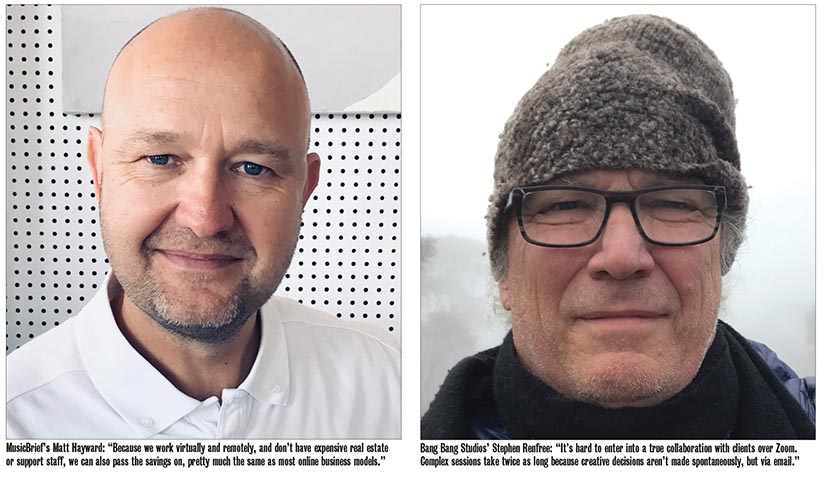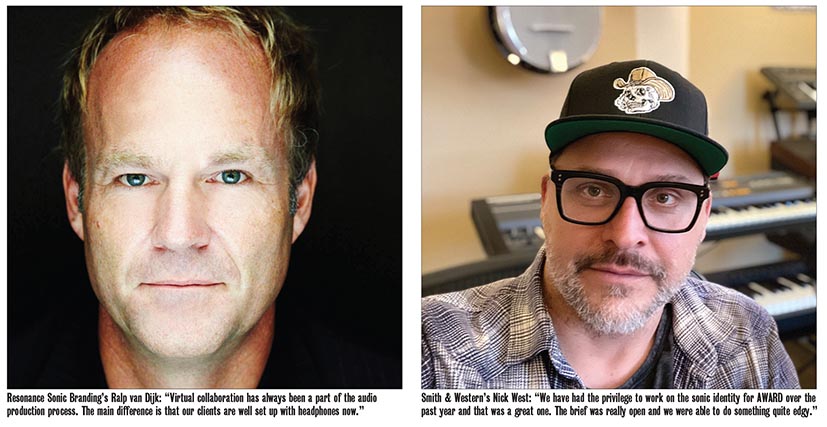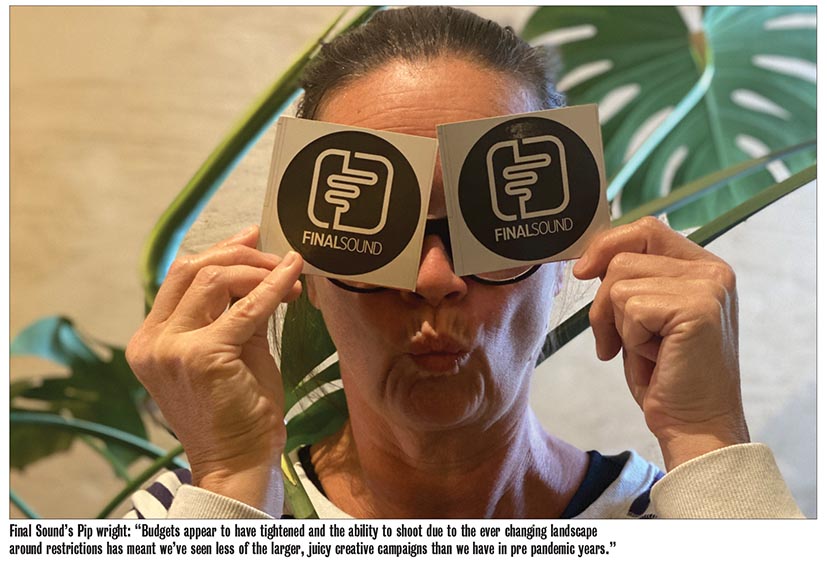SOUND+MUSIC: STATE OF THE INDUSTRY 2021

Pushing sound houses to find seamless solutions to work with clients, creatives and talent remotely, the forced pandemic lockdowns have had a major impact on the day-to-day operations of Australia’s leading studios. Campaign Brief leans in for a sound check on the highs and lows of the year…
It’s been 18 months of building remote communication technologies into standard practice for most sound houses and the biggest challenge, according to Sonar executive producer Sophie Haydon, has been continuing to improve and enhance the quality and stability of remote recording to make the experience of attending virtual mixes as simple and straightforward as possible.
She says: “One of the most significant changes to our workflow has been in limiting physical attendance at the studio and incorporating remote communication technologies into our everyday sessions. The ability to have clients remotely attend sessions from all over the world is something that all businesses will continue to utilise in the future and we’ve seen an increase in interstate and global projects as remote working has become very much normalised.”
And whilst client and talent collaboration online is a good workaround, Rumble Studios partner and executive producer Michael Gie admits you don’t get the same synergy and flow, especially when it comes to experimentation.
“Day to day, we still want to create a great experience. Lockdown has allowed us to develop our tech so everything online runs smoothly, but also given us space to make improvements in the studio for when lockdown ends.”
Gie adds that audio is also being compressed and running through so many channels, that subsequently, everyone is now listening on laptop speakers and mobile headphones.
It’s an issue also addressed by Squeak E. Clean Studios head of post production (Sydney) Emma Hodge. Says Hodge: “Everyone is listening from their laptops these days and what you hear from your WAV or MP4 is very different from what your sound engineer hears and what we send you. We must also ensure that we push back and use our online mixes for online and our TV for TV broadcast. The difference in these mixes is huge. If you put a TV mix to Online it will sound too quiet.”
Squeak E. Clean Studios head of sound in Melbourne, Paul Le Couteur, adds: “Regionally based lockdowns have placed incredible challenges in recording voices, collaborating and mixing at the highest level. Being able to digest what these changes mean and yet still be proactive in our responses has required a lot of brainpower and a lot of sweat. Client pressure for deadlines not to move has meant that our responses have had to be swift yet considered.”
The current climate has also seen full-scale production pared back for some studios. Final Sound producer Pip Wright says: “Budgets appear to have tightened and the ability to shoot due to the ever changing landscape around restrictions has meant we’ve seen less of the larger, juicy creative campaigns than we have in pre pandemic years.”
Adds Final Sound owner and sound designer Craig Conway: “The pandemic has pushed us to think creatively about the way we can work with clients, creatives and talent remotely. Home studios, Source Connect, and Zoom is now the new norm and we are thankful for the accessibility provided by this technology.”
As specialists focused on just one aspect of music — finding and licensing songs for advertising, Music Mill was not involved in the challenges of sound production per se. However, Music Mill managing director Bruce Tweedie thinks the biggest challenge with lockdowns going up and down in various jurisdictions has been the cancellation and postponement of work.
“There is also the issue of not being able to shoot – it obviously doesn’t affect us directly, but when it goes on for too long a lot of the work simply dries up,” he explains.
“We’ve been WFH since we started 21 years ago, so it’s nothing new for us; our operations are well geared for that. The biggest impact is that for long periods of time we haven’t been able to go and see people, and that has been very frustrating, particularly when we would love to catch up with our clients in places like New Zealand. It was wonderful to spend a week visiting clients in Brisbane back in June, but almost immediately the doors slammed shut again and we couldn’t travel anywhere.”

For Bang Bang Studios co-owner and sound designer, Stephen Renfree, coping with mental health issues that emerge from working from home for long periods of time is an issue he believe is one of the biggest challenges for the sound industry.
“It’s hard to enter into a true collaboration with clients over Zoom. Complex sessions take twice as long because creative decisions aren’t made spontaneously, but via email, and no one gets a true sense of ownership that way,” Renfree explains.
On a lighter note, he thinks voice-over artist home setups means its possible to cast from anywhere with no cost impacts.
“The technology enabling remote recording and client attendance has become better and more solid, and I think a lot of routine session work will continue to happen remotely whatever happens.”
Ralph Van Dijk, co-creative director of Resonance Sonic Branding, a joint venture between Song Zu and Eardrum, says virtual collaboration has always been a part of the audio production process. “The main difference is that our clients are well set up with headphones now.”
Ramesh Sathiah, co-creative director of Resonance Sonic Branding, adds that brands are now realising the importance of having a sonic identity: “There’s a lack of understanding in the criteria and process needed to ensure the best result and each week we hear examples of audio branding that lack meaning and substance. Our role is to create long-term brand assets, and that’s something that shouldn’t be rushed.”
Sounding out the future
The advent of working virtually has some sound houses seeing more interstate jobs come through. Haydon says this is true for Sonar, and that the barriers of doing business internationally have also eroded, adding the main obstacle is the high dollar and perceived time zone issues.
Working mainly on Australian briefs, this year Rumble Studios has seen an uptake of work out of the U.S– from San Francisco to L.A and New York City, along with briefs from the U.K, New Zealand and Asia.
Gie says: “We’ve been working with Pereira O’Dell USA over the year, reintroducing Yellowtail wine to America. It’s been a beautifully synchronised dance of time zones, creatives and talent and has been really successful. We’ve also been able to engage more artists, particularly vocalists and actors, who are unable to perform as much on stage this year.”
Landing jobs out of Australia and New Zealand, Music Mill is also receiving projects from Asia and the U.K, although Tweedie admits not as many as in pre-Covid times, due to limited access to the region.
Music Mill just hired McKenzie Roberts, a graduate of the JMC Academy in Brisbane. Commenting on the new appointment, Tweedie says: “It’s never difficult for us to attract quality candidates because so many talented young people with an interest in music would love to work for a music supervision company, and opportunities are pretty rare.
“The real issue for us, like so many organisations around the world, is not the recruitment process; it’s the requirement to do training remotely. We’ve invested a lot of time into making that as professional as possible, but no matter what you do it’s not the same as face to face.”
Renfree says Bang Bang Studios has found it hard to find upcoming talent, but not entirely because of the pandemic. “Our traditional training paths (juniors in the dub room working their way into sound design) no longer exist because, of course, everything is now despatched electronically from the agencies or their third parties,” he explains. “But with much difficulty we have found a new sound designer, and we’re looking for a new production assistant.”

This year Resonance Sonic Branding has found jobs coming in from all over Australia and throughout the APAC region, both direct from brands as well as via design and advertising agencies.
Says Sathiah: “We’ve had to grow fast to keep up with demand and fortunately we’ve been able to recruit the services of Dominic Burnham in our strategy team and Ryan Dickenson who has returned home after working as a senior music creative with Massive Music in Amsterdam.”
Final Sound was excited to welcome Sophia D’Urso as studio assistant. Says Final Sound sound designer Paul Shanahan: “Sophia has worked wonders behind the rebranding of our online presence. We have been working with sound designers, composers and engineers from all around the world for some time now, so we haven’t found much of a shift in that department.”
This year the studio had the pleasure of working with artists and curators for video and sound installations. A standout project was video work ‘New Futures™’, created by artist Laresa Kosloff for Sutton Gallery in Melbourne. ‘New Futures™’ is the third in a series of short films by Kosloff that use commercial stock footage to explore the socio-political conditions of late capitalism.
Squeak E. Clean Studios executive producer (Melbourne) Ceri Davies says most of the studio’s work arrived from locally based clients – although working remotely did open the door to former clients now based interstate.
She says: “Alongside that, rather than being restricted to cast locally, we were able to cast from all around Australia from people who had set themselves up at home or from a city that wasn’t in lockdown.”
This year the studio hired sound designer Dee Gjedsted and sound designer/mix engineer Rob Stephens, adding them to the Melbourne roster.
Says Paul Le Couteur: “Finding the right people at the best of times in a niche business is hard but finding two has been a great achievement. Dee is an amazing experienced creative sound designer with many campaigns and awards under his belt. And Rob is both a skilled and talented sound designer and a gifted musician, fulfilling a hybrid role in our new purpose built studio upstairs in Melbourne.”
Squeak E. Clean Studios executive creative producer (Sydney) Karla Henwood adds: “At the height of the pandemic, our Sydney-based senior producer Angelina Phengphong moved to Chicago to expand the company’s post offerings across our three U.S studios. She has not only taken her expertise in audio producing to Chicago, but also our processes and Aussie X-factor, to ensure seamless collaboration for our clients across all time zones.
“We’ve also welcomed new leadership appointments. From Los Angeles, we announced our executive creative producer Michael Gross, with Anna Lascurain taking on the role as a producer in the Midwest and Kit Winter as executive producer on the East Coast.
Oliver Juke joined the Sydney Studio as music production coordinator, and we are proud to announce our newest composers, Yonít Spiegelman and Charles Rojas, both out of NYC.”
In response to a massive increase in interest for bespoke sonic branding this year, Smith & Western Sound creative director, composer & sound designer Nick West reveals they have launched a new arm of the business, titled S&W Sonic Branding. West says: “Specialising in the holistic sound of a brand we are becoming involved early on in the branding process to help define how sound fits in with the brand architecture and identity. S&W Sonic branding act as consultants working together with branding agencies and clients to curate how the brand sounds.”
One great project for West this year was a partnership with AWARD. He says: “We have had the privilege to work on the sonic identity for AWARD over the past year or so and that was a great one. The brief was really open and we were able to do something quite edgy. The unfortunate thing was that AWARD was a virtual event this year and we didn’t get to hear all the stuff in the big auditorium. We have also found the motion graphics companies have been partnering up with us a lot more recently as they are super busy due to fact that shooting has been difficult. Our partnerships with large and small motion designers around the world has been really fruitful and we have been working on a lot more animated work overall.”

Pandemic Ripple Effects
The pandemic marked a clear moment where the creative process for music and sound was noticed by consumers worldwide, and from pretty early on. Says Henwood: “In March 2020, when early pandemic ads were underway, brands veered toward using similar sombre tracks, often piano. Their campaigns all hit at once, quickly associating the beginning of the pandemic with music now known as the ‘sad piano’ trend. Likely because of its sheer prevalence and Covid-19 related consumer concern, people quickly grew tired of the trend and wanted to hear ‘anything but piano’ accompaniment.”
She says now the trend in music is shifting to a more uplifting and optimistic outlook, even as variants of the pandemic still continue and we’re not all carefree just yet. “Having said all that, musical trends do vary from country to country; our Australian offices saw less of a negative reaction to piano tracks than our U.S counterparts.”
MusicBrief™ founder Matt Hayward says whilst everyone is aware of how tough musicians have been doing, right now is the perfect time to use bespoke music compositions for projects.
“Even before the pandemic hit, musos were struggling to make ends meet with the small amount of revenue they receive from streaming service or production library music syncs. At least before the pandemic some of them were able to supplement their incomes with live performance fees, but that of course has now been hugely impacted, especially with all the lockdowns we are experiencing in places like Sydney and Melbourne. Accordingly I would urge any client, big or small to put their money into a bespoke music composition for their next project, so that not only will they be raising the overall creative bar, they’ll also be helping put food on the table of some very grateful and very deserved folk.”
On average, MusicBrief™ gets 10 to 15 requests every week from professional screen composers around the world wishing to join its roster. Its online business model, and process of procuring bespoke music via a platform has, according to Hayward, made the whole creative process faster, easier and more cost effective for agencies and brands alike.
He says: “I think we were just ahead of the curve really with our thinking, and expect to see this way of working becoming the norm for screen composers as we move forwards beyond this pandemic. Because we work virtually and remotely, and don’t have expensive real estate or support staff, we can also pass the savings on, pretty much the same as most online business models.”
